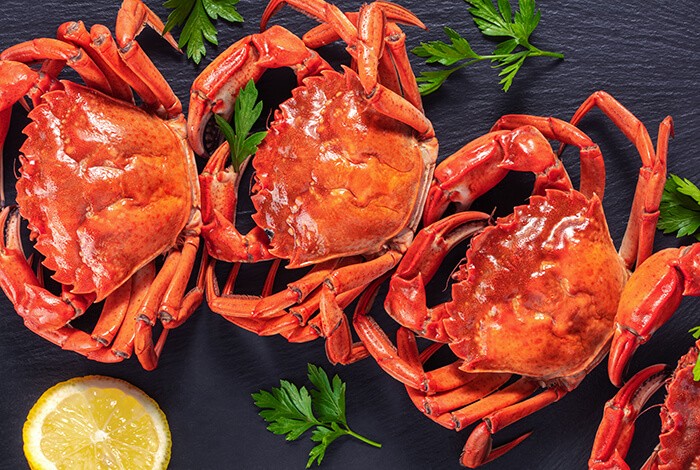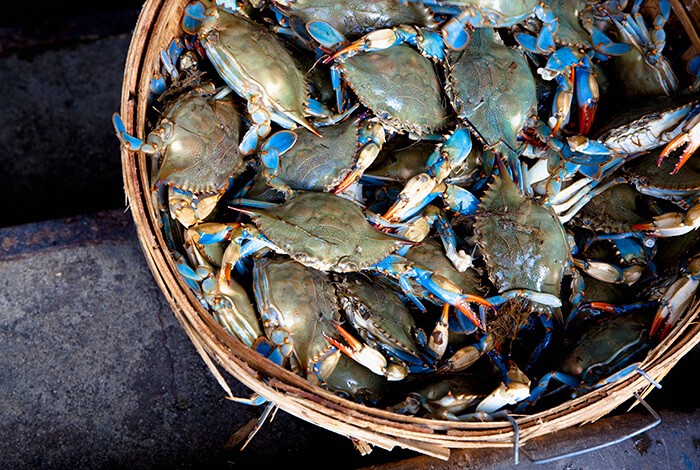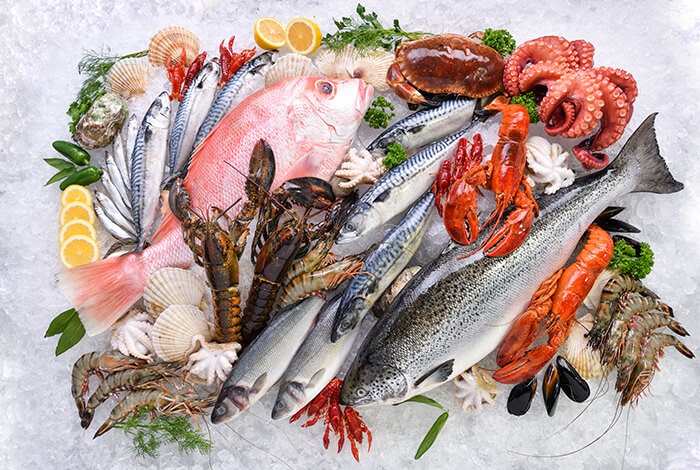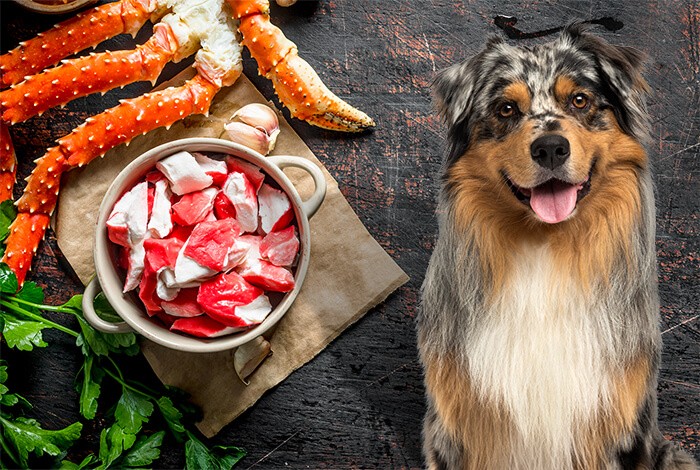![]() Reviewed By Joana Garrido DVM
Reviewed By Joana Garrido DVM
Crabmeat supports healthy cognitive and thyroid health, but it may cause allergies and other health problems if excessively fed to dogs.
Know the precautions to take before tossing crabs into your dog’s food bowl.
Health Benefits of Crabs for Dogs
Crab is a healthy seafood treat for dogs. It is a source of protein that is essential in creating amino acids. These play an important role in restoring the quality of hair, nails, skin cells, muscles, tendons, and cartilage in the body.
Crabmeat has high levels of certain vitamins and minerals. For example, vitamin B12 is dense in this seafood and is important for healthy brain function in dogs.
Crabmeat is a good addition to dogs with exocrine pancreatic insufficiency and protein-losing enteropathy due to its high vitamin B12 concentrations.
Zinc and omega-3 fatty acids can also be found in crabs. Regulating metabolic processes and supporting the immune system and thyroid functions are among the many positive effects of zinc in dogs.
Omega-3 fatty acids, on the other hand, work well in preventing diseases caused by chronic inflammations, such as arthritis and allergies. They also strengthen the heart to keep cardiovascular problems at bay.
When Is Feeding Crabs Harmful to Dogs?
 Carelessly feeding crabs to dogs can be harmful to their health. Here are the most common health issues that may emerge:
Carelessly feeding crabs to dogs can be harmful to their health. Here are the most common health issues that may emerge:
Choking and Impaction
Many dog owners ask: “Can dogs eat crab legs and shells?” The answer is no. Crab legs and shells are dangerous to dogs. These can easily break into sharp shards and get lodged in their throats, causing them to choke.
Crab shells and legs become more deadly if swallowed. These can pierce and damage the internal organs, leading to internal hemorrhage.
Your dog’s gastrointestinal tract will also have a hard time breaking them down because of their tough exterior. It puts him at risk of impaction or stomach blockage.
Iodine Sensitivity
Crabmeat is high in iodine, which some dogs are sensitive to. As a result, they may experience digestive upset, diarrhea, and lethargy after eating this lean protein.
If it is your dog’s first time having crabs, exercise caution. Feed it in small amounts. However, if you already know that he has iodine sensitivity, do not include crabmeat in your dog’s diet.
Hypernatremia
Crab is high in cholesterol and sodium. Both are difficult for dogs to digest if ingested in large quantities.
It can lead to an imbalance of electrolytes or hypernatremia. Ignoring this condition can cause more serious health problems.
Hypernatremia disrupts blood circulation in dogs, resulting in high blood pressure. In the long run, this will give way to the development of heart disease.
Allergic Reaction
Some dogs are allergic to crabs. To assess if your pooch has this condition, let him sample the food in small portions. Observe for any symptoms of allergy afterward, such as:
- Diarrhea
- Vomiting
- Runny nose
- Facial swelling
- Watery eyes
- Loss of energy
Bring your dog to the vet if he begins to show signs of an allergic reaction. Severe cases of this problem will cause intense swelling in the throat, which needs immediate medical attention.
Bacteria and Parasitic Infections
Never feed raw crabmeat to dogs since it is full of intestinal parasites and bacteria. These can cause dangerous infections and weaken your dog’s immune system.
Is cooked crab good for dogs than raw crabs? Yes, cooked crab is good for dogs compared to raw ones. The cooking process eliminates bacteria and parasites in crabmeat.
How to Prepare and Feed Crab to Dogs
Crabs is a nutritious seafood that you can share as an occasional treat with your furry pal. Here are some reminders for safety when feeding them to him:
- Do not feed crabmeat raw. Make sure to cook it completely. The heat must reach a minimum internal temperature of 145 degrees Fahrenheit. Be careful not to feed your dog undercooked crabs since they may still contain intestinal parasites.
- Avoid adding other ingredients such as butter, salt, and spices. Serve crabmeat plain to prevent upsetting your canine companion’s sensitive stomach.
- Get rid of crab shells before feeding. Always double-check every crab for remnants of its shells. If there are any, discard them. Doing so will keep your dog safe from choking and intestinal blockage.
- Offer crabs to your dog in small amounts. Ideally, do not feed more than 1 crab for every 18 pounds of the dog’s body weight. It will reduce the likelihood of side effects from taking place.
What Types of Crab Are Safe for Dogs?

Although the answer to “Can dogs eat crabmeat?” is yes, there are some varieties you should keep away from dogs. Continue reading to know which types of crab you can safely give to your pooch.
Can Dogs Eat Imitation Crabmeat?
No, dogs should not eat imitation crabmeat. It is a mix of processed white fish, food coloring, and other additives with no nutritional value.
Dogs eating large portions of imitation crabmeat can have gastric problems, which harm their intestinal health.
Can Dogs Eat Crab Sticks?
No, dogs should not eat crabsticks. Imitation crabmeat is often used to make crabsticks instead of real crabmeat.
Your furry companion will not gain any essential nutrients from eating crabsticks.
Can Dogs Eat Crab Salad?
No, dogs should not eat crab salad. It is made up of many ingredients, including mayo, dressing, and other seasonings. Your pooch will have difficulty digesting these and may suffer from digestive upset.
Crab salad often contains onions too. This ingredient is quite deadly to dogs as it can cause poisoning and hemolytic anemia.
Can Dogs Eat Canned Crabmeat?
No, dogs should not eat canned crab meat. It is full of preservatives such as:
- Sodium benzoate
- Sorbic acid
- Butylated hydroxyanisole (BHA)
- Butylated hydroxytoluene (BHT)
According to studies, BHA and BHT increase the chances of colon cancer in humans and animals. Thus, keep canned crabmeat away from your pooch.
Can Dogs Eat Crab Cakes?
No, dogs cannot eat crab cakes. These contain sugar and seasoning that can cause problems to your dog’s tummy.
Cooked plain crabmeat is the safest and healthiest type of crab you can feed to your dog. Avoid feeding him other crab-based food since these may contain the harmful ingredients mentioned above.
FAQs About Crab for Dogs
Can Dogs Eat Whole Crabs?
No, dogs cannot eat whole crabs because some of their parts are inedible. A good example of that is the shells, which can break into sharp shards when chewed, causing mouth injuries.
If swallowed, they might get lodged in dogs’ throats and result in choking and stomach obstruction.
Is Crab Shell Digestible to Dogs?
No, crab shell is indigestible to dogs. Calcium carbonate mostly makes up this part of the seafood, which is very tough to break down in the digestive tract.
Can Dogs Eat Dead Crabs?
No, dead crabs are dangerous to dogs. Bacteria quickly proliferate in their body, which can cause food poisoning.
Can Dogs Eat Crabs on the Beach?
No, crabs on the beach are bad for dogs. As mentioned before, whether dead or alive, these crustaceans are hosts to various bacteria and parasites.
Always supervise your dog when on the beach to keep him from consuming raw or dead crabs.
What Happens When a Dog Eats Crab Raw?
A dog is exposed to many health risks if he eats crab raw. He might ingest harmful bacteria or intestinal parasites that will make him ill.
If he swallows pieces of crab shell, he is at risk of impaction or bowel obstruction. If this occurs, he needs immediate vet treatment to prevent this condition from progressing to life-threatening.
Are There Other Seafood Dogs Can Eat?

Can dogs eat seafood? Yes, dogs can eat seafood because it is teeming with nutrients, including protein, amino acids, omega-3s, vitamins, and minerals.
However, take caution about what type you choose. Some seafood contains more nutrients and is safer than others.
Here are a few choices that you can mix with your dog’s food:
Introducing new food to your dog should be done in small amounts to prevent side effects. It should be done one at a time too.
This will make it easier for you to determine the food allergen in case your pooch experiences an allergic reaction after eating the new food.
Summary
Crab is one of the many nutritious kinds of seafood Fido can enjoy on occasion. It is naturally enriched with healthy omega-3 fats, vitamin B12, and zinc.
However, when on the beach, supervise your dog closely and ensure he does not eat any crab. Ingesting them raw can make him ill.
If our list of dog-friendly seafood above is not enough for you, scroll through our Seafood section to find more alternatives to crabs.

